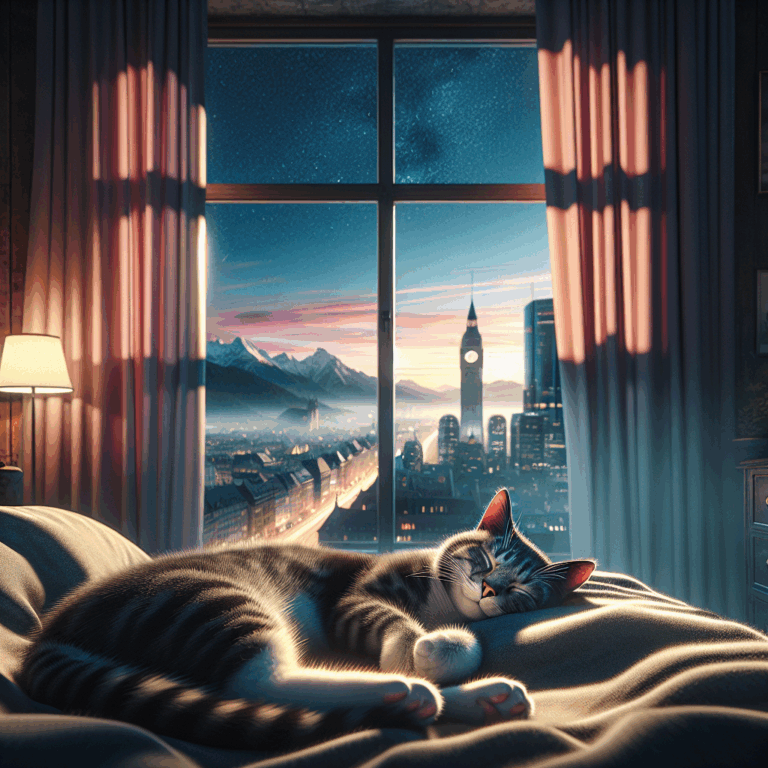The Art of the Cat Nap: Unveiling the Secrets of Feline Sleep Patterns
- 25 Comments
In the world of domestic pets, cats hold the prestigious title of master nappers, often embodying the epitome of relaxation and tranquility. But behind their seemingly idle snoozing lies a complex world of sleep patterns that play a vital role in their health and well-being. Understanding these patterns provides not only a glimpse into the feline psyche but also offers insights into how these creatures have adapted their rest habits over millennia.
Cats are renowned for their ability to sleep anywhere from 12 to 16 hours a day, a trait that harks back to their ancestors. In the wild, felines needed to conserve energy for hunting, which required intense bursts of speed and agility. This necessity for energy conservation has been inherited by domestic cats, leading to their current penchant for long hours of repose. However, unlike humans, cats are not bound by a 24-hour cycle of wake and sleep. Instead, they follow a polyphasic sleep pattern, breaking their rest into multiple short naps throughout the day and night.
These naps are composed of both light and deep sleep phases. During light sleep, which constitutes about 70% of their rest, cats remain alert to their surroundings, ready to spring into action if necessary. Their ears may twitch at the slightest sound, and their eyes often open for a quick scan of the room. In contrast, deep sleep, which occurs in shorter bursts, is when cats experience rapid eye movement (REM) sleep. It is in this phase that cats dream, as evidenced by the occasional twitching of whiskers or paws, and it plays a crucial role in processing memories and maintaining cognitive function.
An intriguing aspect of feline sleep is their adaptability. Cats can adjust their sleep patterns based on their environment and human interactions. For instance, a cat living in a bustling household may sleep more during the day when the house is quieter, while a solitary cat may align its sleep schedule closer to that of its human companion. This flexibility in sleep habits highlights the cat’s ability to coexist seamlessly with humans, further reinforcing their status as beloved companions.
Enrichment activities can also influence a cat’s sleep patterns. Regular playtime and stimulation can help regulate their energy levels, promoting healthier sleep cycles. Toys that mimic prey behavior, interactive games, and even puzzle feeders can satiate their hunting instincts, leading to a more restful sleep. Furthermore, providing a variety of cozy resting spots can encourage cats to settle down in safe, familiar environments, enhancing their sense of security and comfort.
As cat owners, understanding these intricate sleep patterns allows us to better cater to our feline friends’ needs. Creating a harmonious environment that respects their natural behaviors can significantly enhance their quality of life. In return, we are rewarded with the comforting presence of a purring companion who, after a satisfying nap, is ready to engage with the world around them with renewed vigor.
The art of the cat nap is a testament to the delicate balance between activity and rest that defines a cat’s life. By appreciating and accommodating their unique sleep patterns, we not only foster a deeper bond with our pets but also contribute to their overall happiness and health, ensuring they continue to thrive in our homes as elegant, restful creatures.

In the world of domestic pets, cats hold the prestigious title of master nappers, often embodying the epitome of relaxation and tranquility. But behind their seemingly idle snoozing lies a complex world of sleep patterns that play a vital role in their health and well-being. Understanding these patterns provides not only a glimpse into the feline psyche but also offers insights into how these creatures have adapted their rest habits over millennia.
Cats are renowned for their ability to sleep anywhere from 12 to 16 hours a day, a trait that harks back to their ancestors. In the wild, felines needed to conserve energy for hunting, which required intense bursts of speed and agility. This necessity for energy conservation has been inherited by domestic cats, leading to their current penchant for long hours of repose. However, unlike humans, cats are not bound by a 24-hour cycle of wake and sleep. Instead, they follow a polyphasic sleep pattern, breaking their rest into multiple short naps throughout the day and night.
These naps are composed of both light and deep sleep phases. During light sleep, which constitutes about 70% of their rest, cats remain alert to their surroundings, ready to spring into action if necessary. Their ears may twitch at the slightest sound, and their eyes often open for a quick scan of the room. In contrast, deep sleep, which occurs in shorter bursts, is when cats experience rapid eye movement (REM) sleep. It is in this phase that cats dream, as evidenced by the occasional twitching of whiskers or paws, and it plays a crucial role in processing memories and maintaining cognitive function.
An intriguing aspect of feline sleep is their adaptability. Cats can adjust their sleep patterns based on their environment and human interactions. For instance, a cat living in a bustling household may sleep more during the day when the house is quieter, while a solitary cat may align its sleep schedule closer to that of its human companion. This flexibility in sleep habits highlights the cat’s ability to coexist seamlessly with humans, further reinforcing their status as beloved companions.
Enrichment activities can also influence a cat’s sleep patterns. Regular playtime and stimulation can help regulate their energy levels, promoting healthier sleep cycles. Toys that mimic prey behavior, interactive games, and even puzzle feeders can satiate their hunting instincts, leading to a more restful sleep. Furthermore, providing a variety of cozy resting spots can encourage cats to settle down in safe, familiar environments, enhancing their sense of security and comfort.
As cat owners, understanding these intricate sleep patterns allows us to better cater to our feline friends’ needs. Creating a harmonious environment that respects their natural behaviors can significantly enhance their quality of life. In return, we are rewarded with the comforting presence of a purring companion who, after a satisfying nap, is ready to engage with the world around them with renewed vigor.
The art of the cat nap is a testament to the delicate balance between activity and rest that defines a cat’s life. By appreciating and accommodating their unique sleep patterns, we not only foster a deeper bond with our pets but also contribute to their overall happiness and health, ensuring they continue to thrive in our homes as elegant, restful creatures.



25 thoughts on “The Art of the Cat Nap: Unveiling the Secrets of Feline Sleep Patterns”
This insightful article beautifully highlights the fascinating and intricate sleep habits of our feline companions.
It’s wonderful to see an appreciation for the complexities of feline sleep. Their habits truly are fascinating and enrich our understanding of these amazing pets.
This post offers insightful information about the sleeping habits of cats and how these habits have evolved over time.
This insightful exploration of feline rest habits beautifully highlights the balance between activity and tranquility in our beloved pets.
It’s wonderful to see how the article captures the essence of cats’ unique sleep patterns and their ability to balance rest and activity so well.
“The insights into feline rest habits beautifully highlight the harmonious relationship between cats and their environment.”
This insightful exploration of feline sleep patterns beautifully highlights the importance of understanding and accommodating our cats’ natural behaviors.
It’s crucial to acknowledge that prolonged sleep in cats, while inherited from their ancestors, can sometimes be mistaken for lethargy, indicating potential health issues that require attention.
This insightful exploration of feline sleep patterns highlights the fascinating adaptability and restful nature of our beloved cat companions.
I’m pleased you found the exploration of feline sleep patterns fascinating. Cats truly are remarkable in their adaptability and ability to rest, making them such cherished companions.
It’s wonderful to hear that you enjoyed the insights into feline sleep patterns. Cats’ adaptability and restful nature certainly contribute to their charm as beloved companions.
This insightful post beautifully highlights the fascinating world of feline sleep and enhances our understanding of our beloved pets.
It’s great to see the fascinating aspects of feline sleep being appreciated and understood. Our pets truly have unique and intriguing behaviors that enrich our lives.
This insightful post beautifully highlights the fascinating sleep habits of our feline friends, enhancing our understanding and appreciation of their restful nature.
It’s wonderful to hear that you found the article insightful. Feline sleep habits truly are fascinating and contribute so much to our understanding of these amazing companions.
This insightful post beautifully highlights the fascinating world of feline sleep, offering valuable knowledge for cat enthusiasts.
While the exploration of feline sleep patterns is insightful, the post overlooks the impact of sleep disruptions on cat behavior and health.
Exploring the nuances of feline sleep offers fascinating insights into our beloved cats’ world, enhancing our appreciation for their unique habits.
This insightful piece beautifully captures the fascinating intricacies of feline rest habits and their importance.
It’s wonderful to hear that you found the exploration of feline rest habits fascinating. The way cats have adapted their sleep patterns over time is truly remarkable.
I appreciate your interest in the topic! Cats’ ability to adapt their sleep habits over time is indeed fascinating and highlights their unique nature.
This insightful post beautifully highlights the fascinating and adaptable sleep habits of our feline companions.
This insightful piece beautifully highlights the fascinating world of feline rest and their adaptable sleep habits.
Thank you for sharing your thoughts! It’s great to see appreciation for the captivating nature of feline sleep and their remarkable adaptability.
This insightful post beautifully highlights the fascinating sleep habits of cats and how they enhance their quality of life.